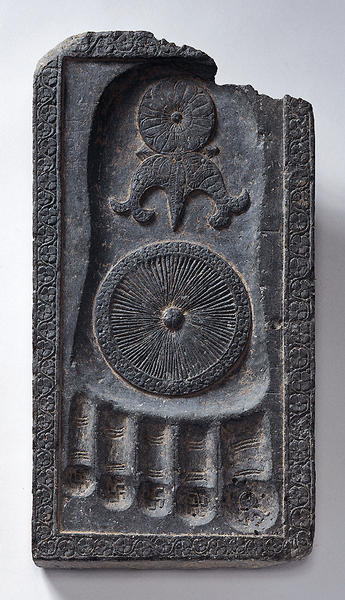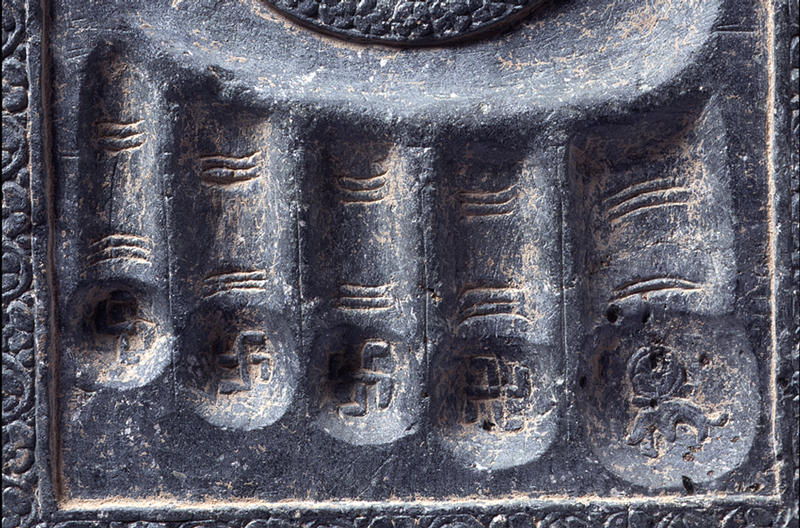Foot Print of Buddha
- Pakistan, Gandhara or Swat
- 2nd - 3rd centuries A.D.
- Schist
- H-75.5 D-17 W-48.5
Catalogue Entry
As the historical Buddha began to be seen as a superhuman one, the idea developed that he had certain physical attributes different from those of ordinary humans. Eventually thirty-two major signs (lakshanas) and eighty minor characteristics (vyanjanas) were described as distinguishing the physical form of the Buddha, though different texts (sutras) vary in the nature of these signs. Such sings, for example, include his soles being flat and marked with auspicious symbols.
During the earliest period of Buddhist art, when the Buddha was not represented anthropomorphically, the Buddha's footprint was one of the symbols which were used in narrative reliefs depicting the Buddha's life scenes to indicate his personal presence.*1 In the Gandharan region, where the Buddha image in human form was first created, there are indications that the Buddha's footprint was worshipped in the same manner as an iconic figure. A Buddha's footprint at the Archaeological Museum, Swat, in Pakistan,*2 is thought to be the one mentioned in the travel records of the Chinese monks Faxien and Xuanzang, who made their pilgrimages in the fifth and the seventh centuries respectively, and worshipped a Buddha's footprint at the northern Swat.*3
The present example is a Buddha's footprint carved on a rectangular slab, the border of which is decorated with a band of meandering vines or cords with four-petaled flowers between them. A triratna or three-jewel symbol is on the pad of the big toe, and the other four toe-tips are marked by a swastika. The triratna mark is a felicitous symbol in which a three-pronged, w-shaped element surmounts a circular flower motif; it symbolizes the three jewels of Buddhism―the Buddha, the Buddhist Law (dharma), and the community of practitioners (sangha). The swastika (svastika in Sanskrit) means "the auspicious". The hooks of the swastikas here do not all face in the same direction, and this variation in the motif is a fascinating aspect of this work. In the center of the sole is a wheel edged with a band of four-petaled flowers. The wheel (dharma-chakra) is a symbol of the Buddha's teachings, or the Buddhist Law, as a perfect circle lacks nothing. Furthermore, the Buddha's teachings penetrate the hearts of faithfuls as the wheel turns, and the act of the Buddha preaching a sermon is called "the turning of the wheel." This wheel motif corresponds to the thousand-spoked wheel said to be one of the thirty-two auspicious physical signs of the Buddha and to appear on the soles of his feet and the palms of his hands. There is also a three-jewel symbol on the heel.
When placed flat, the Buddha's footprint is positioned with the toes direct towards the worshippers, as if the Buddha is facing them, and when it is displayed on walls, their toes point downward. The stone of this example is a greenish schist, which includes a great quantity of mica flakes, which sparkle in the light. This kind of stone was frequently used in the region extending from the northern part of Gandhara to Swat. TK
1 The presence of the Buddha is indicated with his footprints as well as the bodhi tree, an umbrella, a throne, and the dharmachakra or wheel of the Law in the reliefs depicting the Budda's life scenes on the railing from Bharhut (the begining of the first century B.C.) and on the gateways of the Great Stupa at Sanchi (the begining of the first century A.D.); See Koezuka 1979, fig. 68, 72 (Bharhut), 26 (Sanchi).
2 Stein 1930, pp. 56-60, fig. 40.
3 See the Udayana Country sections of the Fa-hsien-ch'uan, and the Ta-t'ang-hsi-yu¨-chi.

